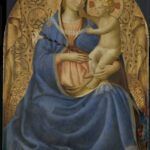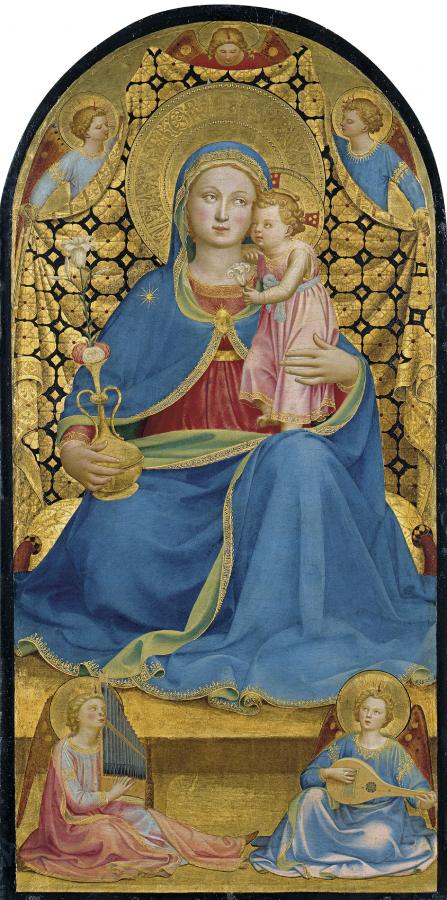Angelico, Fra (c.1395-1455)
Madonna dell’Umiltà (The Virgin of Humility)
c.1433–1435
Tempera on panel, 98.6 x 49.2 cm
Museo Thyssen-Bornemisza, Madrid
©Thyssen-Bornemisza Collection, on loan at the Museu Nacional d’Art de Catalunya (MNAC)
Guido di Piero da Mugello, known as Friar Giovanni da Fiesole, or more popularly, as Fra Angelico, entered the Dominican Order between 1418 and 1421. Vasari, who knew Florentine art and its history at first hand, left an account of him in his Lives, where he devoted eloquent words both to his art and his life, emphasizing the religiosity with which Fra Angelico’s works were always imbued. Vasari noted that “He was constantly engaged in painting and never wished to paint anything other than saints”, that “his art required calm and a life without anxieties”, and that “his works were always considered as beautiful as they were well painted”, that one perceived in them “devotion and natural ability and in fact no-one has painted saints with such a blessed appearance as he”. Vasari also noted other striking aspects of Fra Angelico’s figures, such as the use of “surprising” ultramarine blues in the figures, and drew attention to the beauty and simplicity of his virgins and saints, created to inspire devotion in all who saw them. According to Vasari, for Fra Angelico painting was another way of praying, and it is in this context that we should see his themes, designed and conceived for his own and others’ meditative purposes. With all these virtues, Fra Angelico’s interpretation of various religious subjects such as the Virgin and Child made him exceptionally equipped to lead the viewer towards a direct sense of religious sentiment and contemplation. Vasari also provided information on the origins of this panel, whose early provenance has given rise to some doubts on the part of later art historians. Some authors have identified it with one of the three paintings mentioned by Vasari in his 1568 edition as being in the Florentine collection in the Palazzo Gondi. This has not been uniformly accepted, in part due to the vague description of the painting in Vasari’s text.
The present panel, which can be dated around 1433–35 when the artist embarked on his mature period, has been considered to be part of a polyptych whose other elements remain unidentified.
Fra Angelico used a frontality in his presentation of the Virgin and Child whose origins date back to the Trecento. Nonetheless, the monumentality of both figures and the manner in which the colour is applied, modulating the light, make this a fully Quattrocento work. The cloth of honour held up by three angels with its elegant combination of gold, black and touches of red, was used on various occasions by the artist throughout his career. Its folds function to increase the sense of pictorial depth in the composition.
When he established the chronology of this panel Boskovits compared it with the Linaiuoli Tabernacle of 1433 (Florence, Museo di San Marco), The Coronation of the Virgin (Paris, Musée du Louvre) and The Lamentation (also San Marco, Florence), emphasising the parallels that exist between a number of the figures and the present work. Another artist that has been mentioned is Masaccio, in particular his Pisa Madonna (London, National Gallery) with regard to the musical angels that the artist placed at the Virgin’s feet.
The Virgin of Humility, whose iconography was formulated in the Trecento, is a variant of the Virgin lactans. The mendicant orders, in particular the Domincans, played an important role in its diffusion. Its image was associated with the divine, and Saint Thomas promoted its theoretical and symbolic aspect. In the present composition Fra Angelico refers to Mary’s purity through the flowers, emphasised by the lily that the Infant Christ holds and offers to his mother. The message is repeated in the vase of flowers held by the Virgin and which acts as a visual counterbalance in the composition. In addition to the tall stem of the lily in the vase we also see three roses that recall the rose without thorns traditionally associated with the Virgin. The combination of the colours of the flowers, salmon pink and white, may also refer to the Passion which the Child will later endure. The Virgin of Humility, a theme, so beautifully depicted by Fra Angelico on a number of occasions, is here imbued with a particular tenderness due to the sense of communication between the mother and child. The seated angels, painted on a small scale in the lower foreground, close this composition with its elegant colour range, painted as a devotional image.
Mar Borobia (T-B)
Compare:
 Angelico, Fra (c.1395-1455)
Angelico, Fra (c.1395-1455)
Madonna dell’Umiltà
c.1430
National Gallery of Art, Washington
 Angelico, Fra (c.1395-1455)
Angelico, Fra (c.1395-1455)
Madonna dell’Umiltà
c.1440
Rijksmuseum, Amsterdam
